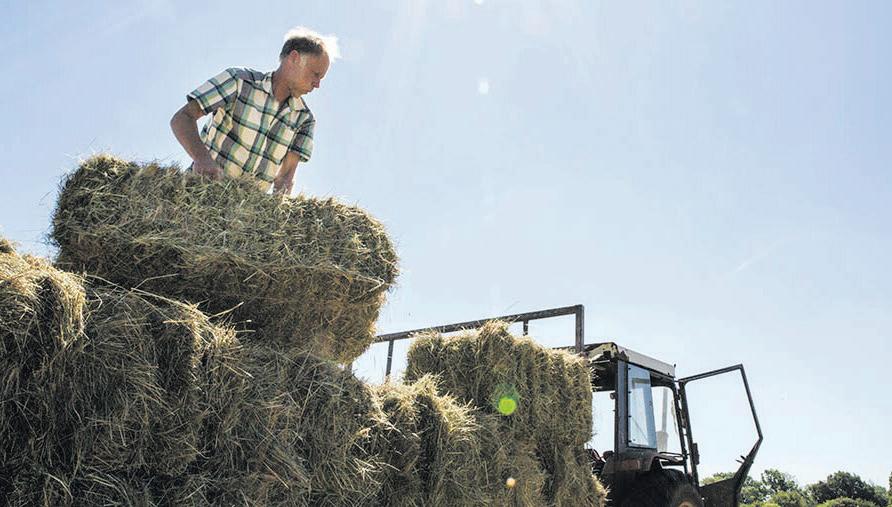
3 minute read
Workforce shortages worsen and grower sentiment plummets one year on from Jobs & Skills Summit
Ausveg
Index is just below El Niño thresholds. In contrast, trade winds and cloudiness near Date Line are fuctuating closer to average and are yet to reach El Niño thresholds.
The Indian Ocean Dipole (IOD) index has been in the positive phase for the past two weeks, but this has to persist for several weeks to be declared a positive IOD event. A positive IOD, together with an El Niño, typically suppresses spring rainfall in central and eastern Australia. The expected onset of these climate drivers is infuencing the hot and dry outlook for spring.
Over the 8-days to 7 September 2023, fronts and troughs are expected to bring isolated showers to southern parts of the country. A high-pressure system is expected to bring mainly dry conditions to the remainder of the country.
Across most cropping regions, minimal rainfall totals of up to 10 millimetres are expected. These falls are not expected to have much beneft to crops and pastures as they are unlikely to be suffcient to offset evaporative losses. Cropping regions in Queensland, northern New South Wales, northern Western Australia and western South Australia have experienced a dry August to date and have well below average levels of soil moisture. Crops and pastures in these areas will be disposed to heat and moisture stress, negatively affecting production potential.
Water storage levels in the Murray-Darling Basin (MDB) increased between 24 August 2023 and 31 August 2023 by 36 gigalitres (GL). Current volume of water held in storage is 21 026 GL. This is 2 percent or 457 GL less than at the same time last year.
Allocation prices in the Victorian Murray below the Barmah Choke remained steady at $155 from 24 August 2023 to 31 August 2023. Prices are lower in the Goulburn-Broken and regions above the Barmah choke due to the binding of the Goulburn intervalley trade limit and Barmah choke trade constraint.
One year on from the Federal Government’s Jobs and Skills Summit, the crippling workforce shortages facing Australian vegetable growers have only worsened, and many growers are now reconsidering their future as vegetable producers.
An alarming sentiment survey conducted by AUSVEG, the vegetable peak industry body, has revealed recordlow morale among Australian vegetable growers, with labour shortages, workforce policy and legislative changes, increased compliance and rising operational costs major factors forcing growers to contemplate their commercial viability.
Appearing at the Senate Inquiry on Food Security in early August, AUSVEG highlighted how increasing costs of production, tightening margins and chronic labour shortages are making vegetable growers question their future in the sector, with more than 30 per cent of Australian vegetable growers now considering leaving the industry within the next 12 months.
The survey also highlighted that:
• 72 per cent are currently experiencing workforce shortages.
• 45 per cent rate their future viability with current workforce shortages as ‘poor to very poor’.
Ahead of the one-year anniversary of the Jobs and Skills Summit on Friday 1 September, the issues raised by AUSVEG in Canberra around workforce availability have still not been addressed, and are expected to deteriorate due to Labor’s recent policy changes that will narrow workforce options.
These new policies were a key concern highlighted by many growers in AUSVEG’s survey. The Working Holiday Maker program, PALM Scheme and overseas student visas, which allow Australian farmers to fll critical labour shortages with overseas workers, have all undergone signifcant changes in recent months.
AUSVEG CEO
Michael Coote said the dire survey results were not overly surprising given the signifcant challenges that growers had faced over recent years.
“We’re a year on from the Jobs and Skills Summit, and unfortunately the only changes the Government have made in that time are making the problem worse, not better,” said Mr Coote.
“Fire, drought, food, rain, hail, labour shortages, volatile markets, biosecurity breaches, unprecedented cost increases to inputs, and many other issues can have detrimental impacts on farmers and rural communities.”
“The toll is showing on vegetable growers, and if even close to 30 per cent of them move away from vegetable production, frequent fresh produce shortages will become the new norm, and Australian families will bear the brunt with higher prices for their produce.”
“While the Agriculture Minister is trying to work with industry, the Albanese Government has not acted on feedback from growers when they’re already being crushed by rising input costs, severe weather and price pressure from the retailers, among other challenges.”
“Vegetable growers just want to be able to grow healthy produce and remain competitive in an increasingly complex business environment, but without an adequate supply of workers, there is a risk that fresh produce will not be planted and families will face higher food costs.”
AUSVEG is calling on the Federal Government to genuinely work with the vegetable industry on workforce policy reforms that uphold the highest standards of worker welfare while also meeting the needs of growers.
“The Australian vegetable sector is forecast to grow by at least an additional billion dollars in annual farm-gate value by 2030, but if we’re hamstrung by workforce availability that potential to grow the Australian economy will be lost,” said Mr Coote.

©Commonwealth of Australia 2023, Australian Bureau of Meteorology Issued: 30/8/2023
Note: The rainfall analyses and associated maps utilise data contained in the Bureau of Meteorology climate database, the Australian Data Archive for Meteorology (ADAM). The analyses are initially produced automatically from real-time data with limited quality control. They are intended to provide a general overview of rainfall across Australia as quickly as possible after the observations are received. For further information go to http://www.bom.gov.au/climate/ rainfall










